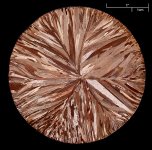After a bit of Googling to learn what a pressurized hard line is, I am somewhat astonished that this technique hasn't yet made an appearance in the high-end audio circus? (Someone please prove me wrong)
Audiophools went for water filled instead!
Currently you are using forced response test method, it is necessary to look at the natural response. For example, hold a dc value and then open the connection at the source instead of forcing it to zero.
Actually, it is the delayed release of stored energy that masks much audibility of changes. So you need tests that show the natural response of a system, not the forced response method which we normally use.
This sounds like an obfuscated explanation of dielectric absorption, does that matter for in audio band signals?
As for the directionality, I assume those who claim it to exist, probably have the OCC (Ohno Continuous Cast) conductor in mind which is supposedly invented by a certain Dr. Atsumi Ohno (1926-2017)?
Patent US4665970 - Method of producing a metallic member having a unidirectionally solidified ... - Google Patents
Unfortunately there isn't much information about Mr. Ohno.
I am not a physicist, but researched a little on how electrons behave in conductors with respect to crystal lattices, grains and impurities, so it seems to have to do with crystal grain boundaries where two grains have different crystal lattice directions and therefore there will be a small "resistance" between the grains for the electron to overcome.
Now if we think of the OCC conductor where the grains are elongated and grouped together in a formation that reminds of the tent pins used for a tipi tent, and where each tipi tent pin grouping is stacked on top of each other making up an elongated conductor.
So if the electron would preferably take the path along inside one crystal grain instead of bouncing over to a neighboring grain because any irregularities would take higher energy to overcome, then it would mean if the electron is moving in one direction it also moves inwards (towards where the tent pins meet together) at the core of the conductor, whereas when the electron travels in opposite direction it would also move outwards, as a side effect when electrons move outwards they would also be more affected by the dielectric properties of the insulator.
Anyhow, if this is what happens and causes the "directionality" effect, if it at all is sonically detectable, then it is a sort of an asymmetric distortion effect, why would we want that?
Attachments
What stumps me most, even if it shouldn't given the reference frame, is how Feynman's work (or the excerpts that are pulled out without much context), which follows code and is absolutely solid, is turned into "I believe something I can't explain and me and you can't measure so you must be stupid and your ways of measuring are no good."
A wonderful example of using terms which have meanings to make sentences which are meaningless.soongsc said:Actually, it is the delayed release of stored energy that masks much audibility of changes. So you need tests that show the natural response of a system, not the forced response method which we normally use.
If you think that Maxwell is "old tech" then are you suggesting that we should use the Standard Model version of quantum electrodynamics to design our circuits? I thought you were reluctant to learn undergradute physics, but now you want us all to use graduate-level physics?How old tech is that? Nothing more recent to add?
That may be true for RF, where L and C dominate. For audio cables, where R and C dominate, the resistance also has an effect. Irrelevant, of course, for domestic audio.john curl said:One might know that the speed of electrical signal is dependent on the INSULATOR MATERIAL
How would you measure a directional cable?soongsc said:So there was no incentive to measure otherwise.
Ah! Now I know why Mr. Soongsc is so persistent in his confusion: it is a source of part of his income. I should have guessed, as this phenomenon is quite widespread.One store in Taiwan offered a customer two pairs of cables to bring home and listen or test, one was mine, and another was a product twice the price.
Actually, there is. You can get a long way by assuming a classical gas of electrons. To do the job properly requires quantum mechanics. However, having explained conductivity using QM you can then use classical EM to explore the consequences when building circuits. Similarly, you need QM to understand how a BJT works; you don't need QM to design good circuits using BJTs. Physics is all about using the appropriate level of explanation; something which seems to be lost on non-physicists.Max Headroom said:There is no way to describe conductivity (in metals)
with classical physics!
This is from someone who has not yet reached undergraduate physics, yet feels able to dismiss it.soongsc said:It does not go deep enough into the subject. If all scientists and engineers stayed at this level, lots of things could not have happened.
Why? The source always remains connected, so the input voltage is forced to whatever the source produces.Currently you are using forced response test method, it is necessary to look at the natural response. For example, hold a dc value and then open the connection at the source instead of forcing it to zero.
What stumps me most, even if it shouldn't given the reference frame, is how Feynman's work (or the excerpts that are pulled out without much context), which follows code and is absolutely solid, is turned into "I believe something I can't explain and me and you can't measure so you must be stupid and your ways of measuring are no good."
Especially when he has exactly the opposite position.
NB his comments on this Chakra nonsensense or the
pseudo-scientific question whether that would be
"making fire" in the Jewish sense when someone
uses an elevator and there was a sparklet in the switch,
which would be forbidden work on sabbath.
( in: You're surely joking, Mr. Feynman )
Or his lecture on Cargo Cult, of which hi end audio is
an example that cannot be topped.
< Cargo Cult Science: Richard Feynman’s 1974 Caltech Graduation Address on Integrity – Brain Pickings >
< Cargo Cult Science >
Last edited:
Basically, if you cannot hear the difference, I recommend not losing sleep trying to figure it out. I don’t try to use measurement to determine directivity because it is just easier to swap till it is right. If anyone wants to know why I started work on cables. Please feel free to read my blog.
Normally I find people whom speculate on the intentions of others is really a reflection of themselves. They just think that others think the way they think.

Dan.
Yes, I apologize for assuming that our two (three, one less vocal at least here) proponents of cable directionality thought in a manner that left some room for linear deductive thinking.
We haven't gotten yet to conspiracy theories but we're not far off. And of course backfire effect is probably in full swing. Ohhhhhhhh welllllllll...
We haven't gotten yet to conspiracy theories but we're not far off. And of course backfire effect is probably in full swing. Ohhhhhhhh welllllllll...
Some time ago, talking with a friend of mine, I mentioned thah I made a Stax phone with integrated DAC. He screamed, "you are a fool? All audio systems need a cable to tune in!"
OUCH
Other thing, to fire the thread, what about connectors and metal quality? Or the use of dissimilar metals on interconnnect plugs? Some strrange effect will occur? Audio differences?
Questions Who knows if all these reported claims are in fact connector related?
Who knows if all these reported claims are in fact connector related?
I prefer to use similar connectors makers and metals (eg. all Amphenol gold) for long life without one metal interacting with other and making surface corrosion.
OUCH
Other thing, to fire the thread, what about connectors and metal quality? Or the use of dissimilar metals on interconnnect plugs? Some strrange effect will occur? Audio differences?
Questions
I prefer to use similar connectors makers and metals (eg. all Amphenol gold) for long life without one metal interacting with other and making surface corrosion.
Doubt it. I'm not the one with clogged arteries.
Lots of myths in relation to this as well.
Some time ago, talking with a friend of mine, I mentioned thah I made a Stax phone with integrated DAC. He screamed, "you are a fool? All audio systems need a cable to tune in!"
OUCH
Other thing, to fire the thread, what about connectors and metal quality? Or the use of dissimilar metals on interconnnect plugs? Some strrange effect will occur? Audio differences?
QuestionsWho knows if all these reported claims are in fact connector related?
I prefer to use similar connectors makers and metals (eg. all Amphenol gold) for long life without one metal interacting with other and making surface corrosion.
One manufacturer did mention he once received such order. I assume it was you.[emoji6]
One audiophile did give me a set of connectors saying those were the best he ever tried, I sent it to a lab for a quick test, pretty much copper inside and out. The simplicity of the lines is what I liked. An RCA connector design is in the works hopefully it will work with my thin cables as well as the thicker ones. I do mention some of the reasons for a thicker cable on my blog.
Good. (IOW other listeners note the kinds of differences I'm talkin' bout.)I am with Dan (Max Headroom) on this.
Yes. (Wiring direction throughout a system is an important consideration.)I have heard and even own a sample of wire directionality (my CTC Blowtorch) that I cannot emulate with just random wiring (I've tried),
Yes. (and no. So far I have fed only a fraction of what I have determined through long and vigorous experimentation.)but to feed info like this to people who frequent this thread is a waste of time.
Thank you. (Not really a fair fight against those who do not understand what they do not understand.....besides which I'm old school peace loving hippy, share and care.)Dan, keep up the good fight,
Yes this is what I find.but you have to realize that you are reasoning with the 'pitchfork wielding villagers' not people who want to learn something new.
 (such detractors are in no position to comment actually....there also others who confer, and others who are 'listening and learning')
(such detractors are in no position to comment actually....there also others who confer, and others who are 'listening and learning')Dan.
- Status
- Not open for further replies.
- Home
- Member Areas
- The Lounge
- Funniest snake oil theories


